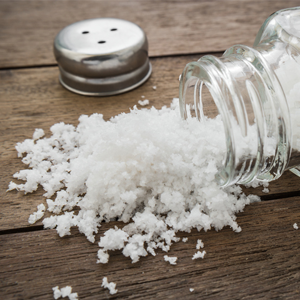
On pizza night, mac and cheese or burger night, you know you’re in for a serious dose of sodium.
But beyond those obviously salty foods,
sodium has a way of sneaking on to your plate more often than you might
realise.
It’s everywhere – starting with the fancy salt you pick up at the organic weekend market.
“All salt contains 40% sodium,” says Mandy Enright, a nutritionist and fitness trainer in New Jersey.
That means Kosher, pink Himalayan and even that fancy French sea salt are all just as bad as the stuff that comes in packets at fast-food restaurants.
Beyond the salt you know you’re adding, tons of sodium is still sneaking its way onto your plate.
“The general rule of thumb is that any processed or man-made food most likely contains sodium – and high levels of it,” says Enright. “If it comes in a can or is pre-made and frozen, there’s salt present.”
And although there remains debate over the more scary potential side effects of excess sodium (like its connection with blood pressure), too much of it can, at the very least, cause bloating and water retention.
According to the most recent dietary guidelines, capping your salt intake at 2 300mg of sodium (one teaspoon) per day is recommended, but most of us are soaring past their salty limit.
The average daily consumption is closer to 3 400mg of sodium per day (about one and one third teaspoons), she says. Next time you’re grabbing groceries, look at the nutrition label and peep at the sodium percentage.
“Anything with 5% or less per serving is considered a low-sodium source, while 20% or more is considered a high-sodium source,” Enright says.
Read more: 12 salt swaps so delicious you won’t notice the difference
Here are four signs you might be getting too much of the seasoning:
1. You’re seriously thirsty
Sodium plays a starring role in helping our bodies balance fluid.
“We need some salt intake each day to help maintain water balance in the body,” says Enright. “The sodium found in salt helps to keep fluid inside our cells.”
When you’re thirsty, Enright says, your body is telling you that there’s not enough water to support how much sodium is in your system, so it sends a signal to your brain to drink up.
Read more: This latest news about sea salt is seriously scary
2. You’re battling a bad case of bloat
Salty meals tend to bring on the dreaded bloat.
“When there is too much sodium floating around the blood, water leaves the cells, causing swelling,” says Enright. “Extreme levels of sodium, followed by excess levels of fluid to balance it out can lead to bloating, particularly the belly area.”
You may also notice swelling in your fingers or toes after a particularly salty meal (we’re looking at you, ramen). Blame the bloat-inducing fluid imbalance.
Read more: 7 ways consuming too much salt can affect your body
3. You have a headache
Ever get a headache for seemingly no reason? Check your last meal.
“Too much sodium can cause blood vessels in the brain to expand, which can lead to painful headaches,” says Enright.
Read more: What’s actually worse for your body? Sugar or salt?
4. Your food tastes meh
On top of all the health risks, consuming loads of salt can actually tweak your taste buds so your food tastes less delicious over time, says Enright. The more salty seasoning you eat, the more you need to get that same mouthwatering response.
“Many people may not realise how much excess sodium they are taking in as a result of changing or dulling taste buds from excess salt exposure,” Enright says.
In other words, it’s a slippery, salty slope.
Read more: Can this de-bloating strategy actually make you gain weight?
How to slash your salt intake
If you are eating too much of the salty stuff, Enright has some easy salt-reducing strategies.
Stay away from the ‘salty six’
“The American Heart Association has dubbed the following foods the “Salty Six”: bread and rolls; cold cuts and cured meats; sandwiches and burgers (particularly those from fast food); pizza; canned soups; and cooked chicken (like those frozen chicken nuggets),” Enright says.
Call on your inner chef
Eating out or getting takeout is a speedy way to make your sodium levels skyrocket – the menu is packed with sneaky salt. “Aim to cook more meals at home, and bring your own food to work or school so you have more control over how much salt is being added to your food,” advises Enright.
Find new flavours
When you cook, experiment with setting the shaker aside. “Aim to get flavours from herbs – both fresh and dried – spices, and acids like lemon juice and vinegar,” Enright says.
Rinse and repeat
When you can’t avoid canned goods, look for “low-sodium” or “no-salt-added” versions. “Rinsing off your beans and legumes can also help remove some of the excess sodium,” says Enright. “Or consider making large batches of dried beans than contain no salt and add your own seasoning.”
This article was originally featured on www.womenshealth.co.za
Image credit: iStock




 Publications
Publications
 Partners
Partners










